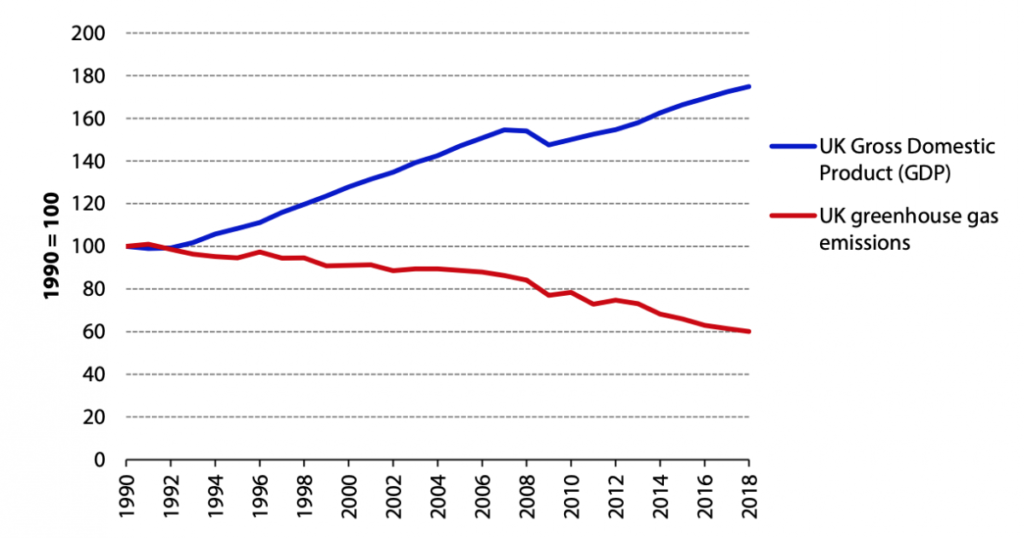There are international, regional and national targets on reducing GHG emissions and combating climate change. In July 2019, the UK Government amended the legally binding target to reduce emissions by 80% by 2050 to a new, much tougher goal. The aim is to have ‘net zero’ GHGs by 2050, meaning emissions from agriculture as well as homes, transport, and industry will have to be avoided completely or – in the most difficult examples – offset by planting trees or sucking CO2 out of the atmosphere. These targets affect everyone in the country and Defra has responsibility for a proportion of the overall reduction that must be met from agricultural processes.
UK Government and Industry Working Group Policy
The Committee on Climate Change advised the UK Government (July 2019 Progress Report) to set emission reductions to net zero by 2050 (instead of the previous 80% reduction). Emission reductions are expected from across all sectors of the economy, including agriculture and forestry. So far in the UK we have seen an overall decrease in emissions released, whilst the average UK Gross Domestic Product increases (graph below) – sounds like good news! However, agricultural emissions increased by 1% from 2016 to 2017 and account for 9% of all UK emissions. Emissions from agriculture were 16% below 1990 levels, but there has been no progress in reducing emissions from agriculture since 2008. Methane accounted for 56% of emissions from agriculture in 2017, and almost half (47%) of total agriculture emissions were from the digestive process of livestock. Emissions from managing agricultural soils, largely resulting from nitrogen fertiliser use, accounted for 25% of the sector’s emissions, with the remainder from waste management and on-farm energy use.

The Greenhouse Gas Action Plan (GHGAP):
An industry-led initiative for delivering reductions in emissions from agriculture in England. The action plan brings together key representative organisations from across the agricultural industry to support collective action. The GHGAP shows the agricultural industry’s commitment to playing its part in tackling climate change, by reducing greenhouse gas emissions by three million tonnes of CO2 equivalent per year from 2018-22. The GHGAP is one of a range of initiatives that is already helping farming to produce more while impacting less.
Part of the Action Plan is to: Meet the climate change challenge without compromising domestic production. It is too simple a solution to produce less and import more. This simply ‘exports’ our emissions to other parts of the world. This action plan focuses on how farmers, across all sectors and farming systems, can become more efficient to help reduce greenhouse gas emissions and make cost savings per unit of production .Agriculture can also make a big contribution to mitigating climate change by storing carbon in soils and vegetation and by generating renewable energy. The Greenhouse Gas Action Plan sets out to show that farming is part of the solution.
The 2016 Review outlined the following Key Points:
This review critically analyses the performance of the GHGAP during the period 2012 through to end of 2016. It is estimated that a 1Mt CO2 equivalent reduction has been achieved as of 2016. The estimate of progress is modelled by looking at the impacts of current uptake of relevant mitigation measures that are covered by the GHGAP. Rates of uptake are mainly taken from the Farm Practices Survey (FPS) which covers a range of mitigation methods, including those relating to organic fertiliser management and application. The GHGAP promotes a wide range of measures not all of which are covered by the FPS, for example some activities around management skills and advice.
Strengths and weaknesses – the agricultural industry should lead but improvements in reporting successes and accountability are required. Government’s preferred approach is to continue with the voluntary GHGAP, with industry taking the lead and the government providing support where appropriate, for example helping to identify the most effective mitigation methods. However, voluntary measures and policies are not really meeting the greenhouse gas emissions reduction targets, and there is a chance that more firm legislation will be required. The GHGAP should include measurable objectives linked to specific mitigation activities and a process for reporting their progress and data shared safely when appropriate between activities and outcomes. The outcome of the referendum to exit the EU provides an opportunity to develop a new vision for British food and farming and our relationship to the natural environment. Improving resource efficiency, including reducing GHG emissions, will be an important part of the thinking that underpins the new vision of the future. The long term plans outlined have been outlined by DEFRA on how to achieve these goals in Food, Farming and the Environmental sectors.
Associated Government Policies
The UK government has a range of measures in place to mitigate climate change, many of which can be utilised by farmers, these include:
- Landfill tax increases; increased gate fees provide an incentive to reduce, reuse and recycle waste wherever possible, while it may also make anaerobic digesters financially feasible.
- Sustainable planning policy; the planning regulations now create requirements for high standards of insulation and other sustainable features in new buildings and conversions.
There are government policies to encourage sustainable soil management and woodland creation which help sequester carbon emissions.
The new environmental bill ensures there will be continued action to cut greenhouse gas emissions including from land use, land use change and agriculture. This includes measures to improve management of fertiliser, manure and slurry to reduce emissions such as ammonia.
The importance of soil management has been also highlighted in the environmental bill; using resources from nature more sustainably and efficiently by improving our soil management approach. The target is to have all of England’s soils managed sustainably by 2030, using natural capital thinking to develop soil metrics and management approaches
Industry Working Group Activities
The Greenhouse Gas Action Plan was developed in collaboration with the major agricultural industry bodies, however groups such as the Agriculture and Horticulture Development Board (AHDB) have also developed ‘product roadmaps’ for their supply chains, outlining how individual sectors, such as livestock production, can reduce their emissions.
The Beef and Sheep meat roadmaps can be downloaded here. This final report (2012) looks at the environmental challenges facing the industry and develops practical ways to reduce the carbon footprint of the sector. The direct emissions from livestock are analysed in conjunction with water use, economic returns, landscape and biodiversity value and waste in the supply chain.
The latest Arable farming roadmap can be downloaded here. This Roadmap is a plan of action for AHDB to assist the UK cereals and oilseeds industry to meet its GHG emissions reduction goals and environmental improvement targets. AHDB provides relevant information and tools to assist in the uptake of environmentally sustainable practices, while, at the same time, supporting a profitable UK cereals and oilseeds sector.
The 2018 UK dairy industry roadmap can be viewed here. This report brings together participants from the entire dairy supply chain including farmers, dairy manufacturers, and industry partners. Together, the British dairy industry has made a commitment to set targets and produce regular reports on the progress it is making to reduce its environmental footprint.
The BPEX 2014 pig meat industry roadmap can be found here. In this report it was established that pig producers in this country can and will deliver further reductions in environmental impact, despite the fact that targets have already been exceeded or look likely to be exceeded by 2020.
EU Policy
The Common Agricultural Policy (CAP), the EU’s farming and rural development funding framework, encompasses many elements that affect climate change and how farmers respond to the challenge.
Under the CAP there are two pillars, one for direct payment support and cross compliance (Pillar 1) and the second for rural development (Pillar 2). The Pillar 1 developments were designed not to incentivise over production but to ensure farmers had met certain environmental management, animal welfare and traceability standards, known as cross compliance. Pillar 2 was designed to encourage sustainable management of natural resources, promote development in rural communities and combat climate change. Rural development funding supports agri-environmental schemes. As CAP developed there was greater acknowledgment of climate change and wider sustainability issues making it a more integral part of farming.
Rural development funding will seek to support agri-environment projects such as climate change mitigation and adaptation, possibly creating new opportunities. However, since deciding to leave the European Union, CAP will be phased out and a new system of payments will be created, this will be known as Environmental Land Management scheme (ELMS). ELMS has been founded on the principle of ‘public money for public goods’, providing a means of achieving the goals set out in the 25 Year Environment Plan and commitment to net zero emissions by 2050. Information on the 25 Year Plan can be found here.
Follow this link for a summary of climate change adaptation and its affects at the EU scale.
Follow this link for a detailed working paper on the agriculture’s mitigation potential at the EU scale.
Related Policy Drivers from the EU
The Renewables Directive, which required the UK to produce 15% of its energy from renewable sources by 2020, therefore creating opportunities in biomass, wind, solar and other renewables.
The Water Framework Directive, which requires much greater consideration of water as a resource, enhanced conservation measures and limits on extraction.Water quantity and quality is now addressed in the 25 Year Environment Plan, directly mentioning meeting or exceeding the measures in the River Basin Management Plans for England.
Renewable Fuels targets – targets have been set for the replacement of transport fossil fuels with renewable sources of energy such as biofuels. Each member state must meet a progressively increasing proportion of its transport fuel from renewable sources, which creates a market for these fuels.
The UN COP21 agreement aims to limit greenhouse gas emissions around the world to keep global temperature rise this century well below 2 degrees Celsius above pre-industrial levels, while pursuing efforts to limit the increase to 1.5oC. This agreement requires each country to report regularly on their efforts and implementation efforts. It is encouraged that through the agreement, countries will conserve and enhance their sinks and reservoirs of GHGs.

